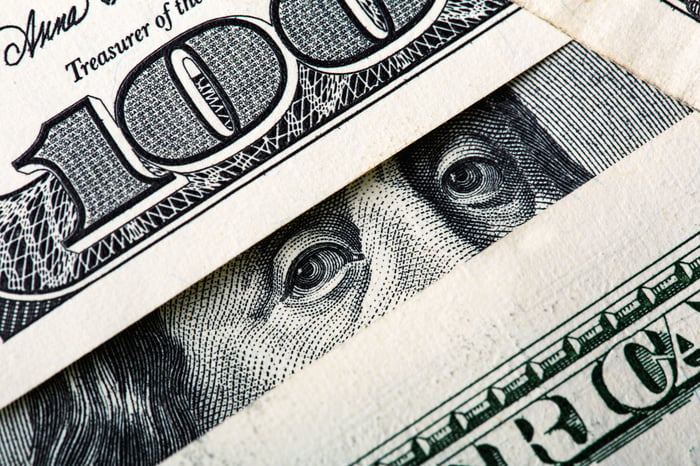Social Security is arguably our nation's most revered social program. Close to 63 million benefit checks head out to eligible recipients each month, with more than 22 million of these folks being pulled above the federal poverty line as a result of their payout. Without Social Security, poverty rates, especially among the elderly, would be significantly higher.
But as you're probably well aware, it's also a program that's facing what might be its biggest challenge since its inception in 1935.

Image source: Getty Images.
Social Security has a $13.2 trillion problem
The June-released annual report from the Social Security Board of Trustees suggested that the program was nearing a major inflection point. More specifically, following 36 years of net cash surpluses, it's soon expected to spend more annually than it collects in revenue. This switch is occurring because of numerous ongoing demographic changes, such as baby boomers retiring and increased longevity over the long run.
The bright side is that Social Security isn't going bankrupt. No matter how many polls you read about millennials not expecting to receive a cent in benefits when they retire, they're wrong. Social Security has almost $2.9 trillion in asset reserves built up since its inception, and this excess cash will help offset some of the sting of spending more than it's bringing in for a while. By 2034, the report forecasts that this nearly $2.9 trillion in asset reserves will be completely exhausted. Assuming Congress hasn't come to the rescue, then-current and future beneficiaries could be staring down a payout cut of up to 21%. As a reminder, more than three out of five retired workers today lean on Social Security for at least half of their income.
In nominal dollar terms, Social Security is facing a cash shortfall of $13.2 trillion between 2034 and 2092, and it's up to Congress to figure out how best to resolve this cash crunch. Lawmakers could choose to raise revenue, cut expenditures, or implement some combination of revenue raising and cost-cutting to fix America's most important social program.
Yet, what's often overlooked is just how much potential revenue is escaping Social Security's payroll tax each year.

Image source: Getty Images.
The wealthy are costing Social Security a lot of money
The payroll tax is the program's workhorse. In 2017, it was responsible for generating $873.6 billion of the $996.6 billion collected by Social Security. And if the program's asset reserves were to disappear, thus removing interest income as a source of revenue, payroll tax would possibly account for in excess of 90% of all collected revenue per year.
Payroll tax is a 12.4% tax rate on earned income (i.e., wages or salary paid to you) up to the maximum taxable earnings cap, which in 2019 is $132,900. The last part of the previous sentence is very important. What it means is that all earned income between $0.01 and $132,900 for American workers is subject to the payroll tax, but that any earned income above $132,900 is exempted from the tax.
Why on earth would Social Security exempt earned income from being hit with the payroll tax? The simple answer is that the earnings cap more or less aligns with the fact that there's a limit on what the program will pay out on a monthly basis at full retirement age. In 2019, the maximum monthly benefit at full retirement age is $2,861. In other words, lawmakers thought it'd be silly to tax say $5 million in annual income at 12.4% if the most this individual could receive each month is $2,861. Thus, the tax cap is merely a reflection of the benefits cap at full retirement age.
More than nine out of 10 working Americans will make less than $132,900 this year, and will therefore be paying into the system on every dollar they earn. Mind you, only the self-employed will owe the 12.4% rate. If you're employed by someone else, you and your employer split the payroll tax liability down the middle, 6.2% each. This means just a single-digit percentage of the working population will sidestep paying tax on a portion of their earnings. But, in 2016, this "portion" equaled $1.2 trillion in earnings. At the 12.4% rate, that's $148.8 billion (nearly $150 billion) in revenue that Social Security is missing out on each year.

Image source: Getty Images.
The most popular Social Security fix: Lift the cap
Perhaps it's not surprising that the most popular Social Security solution among the public would be to increase or remove the earnings tax cap associated with the payroll tax. Any adjustments to the tax cap would have absolutely no impact on more than 90% of working Americans and, in the view of most workers, it would make the system fairer since the wealthy would be paying tax on more of their earned income.
More importantly, if the payroll tax cap were lifted or eliminated entirely, it would generate a substantial amount of extra income for the program. As time has passed, the amount of earnings escaping taxation has increased dramatically. Back in 1984, "just" $300 billion in earnings was avoiding the payroll tax, but as noted earlier, $1.2 trillion is escaping the tax as of 2016. Removing the cap entirely would conservatively add $1.5 trillion (or more) in revenue to the Social Security program over the next decade -- and that's not including the expectation of wage growth, which would probably push this figure closer to $2 trillion.
So, why aren't we taxing the rich and closing this lost revenue gap? Part of the answer lies with the explanation noted earlier. Since a maximum monthly benefit cap exists, a taxable cap exists, too.
Another reason is because it requires 60 votes in the Senate to amend the Social Security program. Since neither political party has had a supermajority in the Senate in 40 years, increasing the tax cap is going to require bipartisan support. The problem is that Republican lawmakers have no desire to increase the tax cap. Rather, they'd prefer to gradually increase the full retirement age from a peak of 67 to perhaps as high as 70. Without bipartisan cooperation, it's going to be nearly impossible to raise the cap.
Until adjustments are made to the tax cap, the rich are probably going to see a higher percentage of their earnings exempted from the payroll tax over time.
 Source: seksan mongkhonkhamsao / iStockMedical equipment and diagnostics firm Danaher Corp. (NYSE: DHR) announced Monday morning that it has agreed to pay $21.4 billion in cash for the biopharma business of the Life Sciences’ division of General Electric Co. (NYSE: GE). The price represents a 17×-multiple to GE Biopharma’s expected 2019 EBITDA.
Source: seksan mongkhonkhamsao / iStockMedical equipment and diagnostics firm Danaher Corp. (NYSE: DHR) announced Monday morning that it has agreed to pay $21.4 billion in cash for the biopharma business of the Life Sciences’ division of General Electric Co. (NYSE: GE). The price represents a 17×-multiple to GE Biopharma’s expected 2019 EBITDA. 24/7 Wall St.
24/7 Wall St. Animation Vision Cash (CURRENCY:AVH) traded up 0.1% against the dollar during the 1-day period ending at 18:00 PM Eastern on February 21st. One Animation Vision Cash token can now be purchased for approximately $0.0005 or 0.00000013 BTC on exchanges including CoinTiger and HitBTC. In the last seven days, Animation Vision Cash has traded up 21.9% against the dollar. Animation Vision Cash has a market capitalization of $0.00 and $45,227.00 worth of Animation Vision Cash was traded on exchanges in the last 24 hours.
Animation Vision Cash (CURRENCY:AVH) traded up 0.1% against the dollar during the 1-day period ending at 18:00 PM Eastern on February 21st. One Animation Vision Cash token can now be purchased for approximately $0.0005 or 0.00000013 BTC on exchanges including CoinTiger and HitBTC. In the last seven days, Animation Vision Cash has traded up 21.9% against the dollar. Animation Vision Cash has a market capitalization of $0.00 and $45,227.00 worth of Animation Vision Cash was traded on exchanges in the last 24 hours. 
 Version (CURRENCY:V) traded up 8.9% against the dollar during the twenty-four hour period ending at 16:00 PM Eastern on February 20th. One Version coin can now be bought for approximately $0.0001 or 0.00000002 BTC on popular cryptocurrency exchanges including YoBit and Cryptopia. During the last week, Version has traded 8.9% higher against the dollar. Version has a market capitalization of $43,847.00 and $40.00 worth of Version was traded on exchanges in the last 24 hours.
Version (CURRENCY:V) traded up 8.9% against the dollar during the twenty-four hour period ending at 16:00 PM Eastern on February 20th. One Version coin can now be bought for approximately $0.0001 or 0.00000002 BTC on popular cryptocurrency exchanges including YoBit and Cryptopia. During the last week, Version has traded 8.9% higher against the dollar. Version has a market capitalization of $43,847.00 and $40.00 worth of Version was traded on exchanges in the last 24 hours.  Hershey Co (NYSE:HSY) has been assigned an average rating of “Hold” from the fifteen ratings firms that are currently covering the firm, MarketBeat Ratings reports. Three research analysts have rated the stock with a sell rating, eleven have issued a hold rating and one has given a buy rating to the company. The average 1-year price target among analysts that have issued ratings on the stock in the last year is $100.82.
Hershey Co (NYSE:HSY) has been assigned an average rating of “Hold” from the fifteen ratings firms that are currently covering the firm, MarketBeat Ratings reports. Three research analysts have rated the stock with a sell rating, eleven have issued a hold rating and one has given a buy rating to the company. The average 1-year price target among analysts that have issued ratings on the stock in the last year is $100.82. 
 Energen Co. (NYSE:EGN) has been given an average rating of “Hold” by the twenty-one brokerages that are covering the stock, Marketbeat Ratings reports. One equities research analyst has rated the stock with a sell rating, eleven have given a hold rating and eight have assigned a buy rating to the company. The average twelve-month price target among brokerages that have issued a report on the stock in the last year is $82.36.
Energen Co. (NYSE:EGN) has been given an average rating of “Hold” by the twenty-one brokerages that are covering the stock, Marketbeat Ratings reports. One equities research analyst has rated the stock with a sell rating, eleven have given a hold rating and eight have assigned a buy rating to the company. The average twelve-month price target among brokerages that have issued a report on the stock in the last year is $82.36. 


